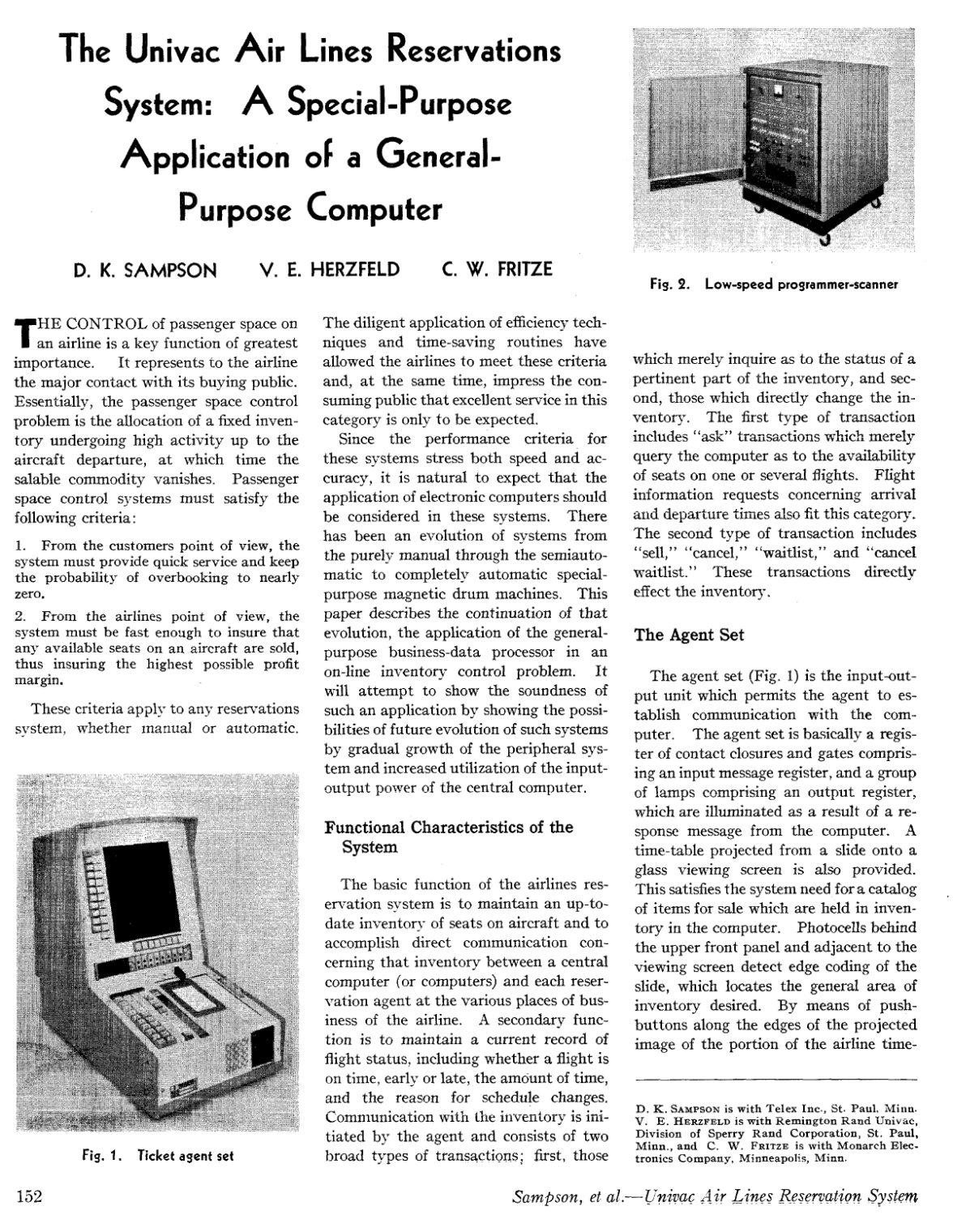I had thought that SABRE, a joint development of IBM and American Airlines, was the first computerized airline reservation system, going live in 1960. However, “The Univac Air Lines Reservations System: a special-purpose application of a general-purpose computer” was published in 1958 and talks about the system being up and running already.
Have a look at the authors’ affiliations at the bottom right. A cautionary tale that success in the computer industry can be fleeting! How powerful was the mainframe?
Transaction processing time wasn’t that different than today’s bloated servers, with their infinite layers of Java, can manage:
The system was up 99.7 percent of the time for its first six weeks and the authors envisioned a future system serving 1,200 travel agents simultaneously.



I like the 180,000 characters per drum. To store my 1 terabyte movie collection, I would need 5 million drums!
J.C.R. Licklider was more correct than he knew. Information processing (or more correctly, Data Processing) in the sense those machines represent is almost a vestigial function of what most people now perceive and use as modern “computers.” He didn’t quite foresee Netflix and the Metaverse.
Perhaps it’s more true to Licklider’s personality to say that “he probably knew, but he was already being pretty bold and didn’t want to sound ‘totally out there’.”
https://www.hpl.hp.com/techreports/Compaq-DEC/SRC-RR-61.pdf
“The Computer as a Communication Device”
“In a few years, men will be able to communicate more effectively through
a machine than face to face. That is a rather startling thing to say, but it is our conclusion.”
…
“For all his considerable influence on computing, Lick retained his modesty. He was the most unlikely “great man” you could ever encounter. His favorite kind of joke was one at his own expense. He was gentle, curious, and outgoing.”
I’ll ask my Dad tonight about his experiences working with Chase Manhattan Bank on some of their first ATMs.
My Dad still vividly remembers the days when a Megabyte of IBM core memory cost a Megabuck or more. Coming to us just now through the magic of the Computer as a Communication Device and the Infinite Elsewhere:
“The 360/75 had 4 BOM’s Basic Operational Memories 2365’s ( https://en.wikipedia.org/wiki/IBM_2365_Processor_Storage ) each BOM had 4 arrays for 64K bytes composed of 64 plus parity doublewords.”
He used to write all of his good programs for processing mail address data in System/360/370 Assembler, and I’ve never to this day seen anyone who could write good commented code in Assembler as quickly. When I was learning BASIC on a TRS-80 Model 1 as a kid, I used to ask him: “Why do you write in Assembler?” He said: “Because I can save a few bytes of data on each record and the program runs much faster.” That was important running a big job on a machine that ran on enough 220V three-phase power to run a suburban block or two, with the A/C to match.
And then there was the 2301 Drum Storage from the mid-60s, which he describes as: “Fiendish.”
http://www.columbia.edu/cu/computinghistory/drum.html
It’s amazing we’re all alive. Count your blessings.
Did it have a poorly implemented version of the soon to be created Lisp?
The first sane IT related article I’ve read in a year. No mention of cloud, block chain, data lakes, hyperconvergence, NoSQL, puppet, chef, Kubernetes, etc.
Here is a quite detailed description of the system SAS built starting from 1958:
https://www.e-pages.dk/ingarkiv/7738/?page=1
… But in Danish.
As far as I know, it was more like a telephone switch, but also with drum memory, than a programmable computer.
We have one of the special terminals for the agents in our collection in datamuseum.dk.
By the early 1960s Univac had improved its airline reservation system and became a leader in the field. Many airlines bought this and successor systems (British European Airways, Northwest Airlines MN, Scandinavian Airlines, Iberia, Lufthansa etc.). In the 1960s I worked for Univac on the BEA implementation and wrote some of the operating system code, which was written entirely in assemler, certainly reinforcing Alex’s dad’s view about speed and efficiency. The system could handle more than 10 transactions per second and was connected to all BEA reservation offices in Europe.
For those interested, here is a link to Issue 43 of Resurrection published by the Computer Conservation Society containing an article titled “Beacon 1963-7: A System Design Ahead of its Time?” https://www.computerconservationsociety.org/resurrection/res43.htm#g